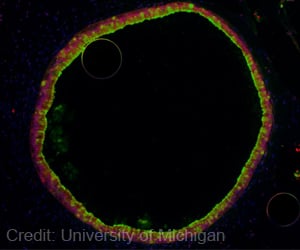Most of us don't know it, but we are infected by the herpes virus aka Epstein-Barr virus (EBV)

"EBV is an important but neglected pathogen," said Henri-Jacques Delecluse of the German Cancer Research Centre in Heidelberg, Germany. "We have made an important step in recognizing that EBV is actually a family of viruses that have different properties, some of which are very likely to cause disease. So, the consequences of being infected with EBV might be different, depending on the strain one carries."
Delecluse and his colleagues made the discovery by sequencing the DNA of a viral strain dubbed M81 isolated from a Chinese patient with nasopharyngeal carcinoma (NPC). Their analyses revealed that M81 is highly similar to other viruses isolated from NPCs and profoundly different from Western strains in terms of its ability to infect and replicate within cells.
The M81 strain can infect epithelial cells and multiply spontaneously at a very high level in all cells it infects, including B lymphocytes, the cells in which the viruses hide, the researchers report. It remains to be seen exactly how infected epithelial cells become cancerous.
"Our results have made me radically change my strategy to address the problem of EBV-associated diseases," Delecluse said. "The current view is that the virus is essentially the same all over the world and that local conditions explain the different consequences of EBV infection. We now show that the type of EBV also plays an important role. By concentrating on the potentially pathogenic EBV strains, we will soon better understand how EBV causes diseases, and this will also help [in] designing prevention strategies."
Advertisement














